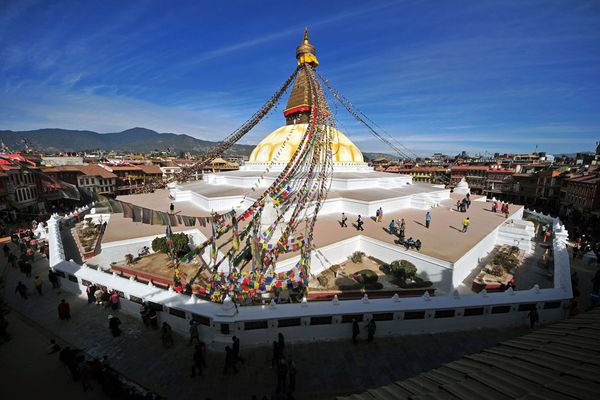 The tremendous ethnic diversity and the physical isolation into which the Himalayan topography has separated the different ethnic groups in Nepal are the prime constituents why even today most Nepalese people in the countryside think still about their country primarily in terms of only the region of the Kathmandu Valley.
The tremendous ethnic diversity and the physical isolation into which the Himalayan topography has separated the different ethnic groups in Nepal are the prime constituents why even today most Nepalese people in the countryside think still about their country primarily in terms of only the region of the Kathmandu Valley.
From the earliest times, the history of Nepal amounts to pretty much nothing more than the history of the Kathmandu Valley, referred to by the hill people by a more general term, the “Nepal Valley” or just simply “Nepal”.
It is true that when the Prithvi Narayan formed the original Kingdom of Nepal, whose territories encompassed areas even greater than what Nepal is today, first national feelings among the people were born. However, for the most part, these first sense of a nation associations were nevertheless primarily Hindu creations, for after all they were the conquerors of the Kathmandu Valley and the surrounding hill territories and the sole creators of the kingdom.
In subsequent years when Nepal, or rather the newly formed Kingdom of Nepal, went to war against the British and Tibet, the Nepal rulers formed an army which included in its ranks representatives of all the native Nepalese tribes, and thus the idea of a country or a nation grew stronger. Ever since then, although Nepal has been able to maintain its political and territorial stability, due to undeniably the physical barrierism inherent in the Nepal”s geography, the center of political, economic and cultural life has nevertheless remained in the Kathmandu Valley. Even though today, the Nepal government seems to involve politically all the people living within its boundaries and also economically some of the development plans are making a breakthrough into the Himalayan countryside, the history of Nepal is nevertheless still related to historical developments taking place in the valley of Kathmandu.
Although the inhabitants of the Nepal Midlands, the population core of the country, whether of the Ancient Nepalese or the Indo-Nepalese racial family, may be heard these days to refer to themselves quite frequently by saying, “We, the Nepali people”, most of them when encountered on one of the Himalayan trails will still answer the question where they are going, “Nepal jaane” (I am going to Nepal), meaning they are “going to Kathmandu.” On the other hand, it is interesting to note that the Tibetan population groups from the Inner Himalayan valleys and outlying northern districts will likely answer, “Kathmandu jaane, ” literally meaning “Going to Kathmandu.”
The case of the Tibetan population groups is in a sense quite unique. Most of them migrated from the regions of Tibet proper already many centuries ago and thus no longer feel any national ties to their motherland. Nevertheless, culturally they have always been affiliated with the Tibetan culture, and prior to the Chinese takeover of Tibet they frequently traveled north on their trading ventures, often as far as Lhasa. In fact, since their livelihood to a great degree depended on trade with their neighbors to the north, they continued doing so even when the Nepal kingdom was created. Ever since the Chinese invasion of Tibet, they, however, were forced to orient their trading activities to the south, and thus consequently they started to become more real a part of Nepal as a political and cultural unit.
Although today many of the former inhabitants of the northern districts, excluding the Tibetan refugees from Tibet proper, live in Kathmandu, most of them still live in their own regions they settled centuries ago. Here they still for the most part pursue their own culture and live their own typically Tibetan lifestyles. And since the former kingdom of Nepal was and even today still is essentially a Hindu country, and had a Hindu king, Nepal is still functioning along well rooted caste lines, the Tibetan population groups as caste free people cannot naturally feel extremely strong national affiliations. Such, however, may be said does exist today among the rest of the people of Nepal, for the Hindu caste value system has been an underlying factor in the lifestyle and the ways of thinking of these people.